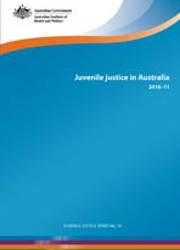Summary
This report focuses on the young people who were under juvenile justice supervision in Australia during 2010–11 due to their involvement or alleged involvement in crime, and the types of supervision they experienced.
Rates of juvenile justice involvement remain low
Few young Australians are involved in the juvenile justice system. In 2010–11, around 3% of those aged 10–17 were proceeded against by police, just over 1% had a case finalised in a Children’s Court, around 0.5% were supervised by a juvenile justice agency in the community, and less than 0.3% were detained.
On an average day in 2010–11, there were an estimated 7,265 young people under juvenile justice supervision in Australia. Most (86% or 6,250) were supervised in the community and the remainder (14% or 1,045) were in detention.
There were 2.6 young people aged 10–17 under supervision on an average day for every 1,000 in the population—2.2 per 1,000 under community-based supervision and 0.4 per 1,000 in detention. Over the 4-year period to 2010–11, rates of young people under communitybased supervision and in detention remained relatively steady.
Supervision rates vary among the states and territories
Juvenile justice is the responsibility of state and territory governments, and differences in supervision to some extent reflect differences in legislation, policy and practice. Among the states and territories, rates of young people aged 10–17 under supervision on an average day in 2010–11 ranged from 1.9 per 1,000 in Victoria to 4.7 per 1,000 in Tasmania (excluding Western Australia and the Northern Territory, as standard data were not provided). There were similar variations in the rates of community-based supervision and detention.
Aboriginal and Torres Strait Islander young people are still over-represented
Indigenous young people aged 10–17 were 15 times as likely to be under supervision on an average day as non-Indigenous young people. This level of over-representation fell slightly over the 4 years to 2010–11.
The over-representation of young people in detention decreased over the 4-year period. In 2010–11, Indigenous young people aged 10–17 were 24 times as likely as non-Indigenous young people to be in detention on an average day, down from 28 times as likely in 2007–08.
Half of those in detention have not been sentenced
Although, on an average day, most young people were supervised in the community, around 2 in 5 (41%) young people under juvenile justice supervision were in detention at some time during the year (excluding Western Australia and the Northern Territory, as data were not provided). Most (87%) of those in detention during 2010–11 experienced unsentenced detention at some time during the year.
On an average day, half (50%) of all young people in detention were unsentenced.



